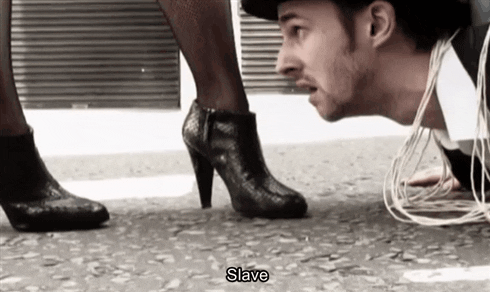A BDSM partnership relies heavily on the separation of power between the Dominant and submissive roles. In the overall essence of the dynamic, the Dom has partial or full control over the sub—with the latter’s enthusiastic consent, of course.
A Dom/sub (D/s) arrangement makes itself evident in various ways, depending on the agreed terms. Most often, the distinction between the two personalities materializes in scenes or plays and other physical interactions. These are the main instances wherein the Dom clearly demonstrates their power over their sub.
Actions say quite a lot but in BDSM, words have just as much bearing. The use of words in the lifestyle typically begins with choosing names. The name or title a Dom or sub comes up for themself is one of the cornerstones of a D/s relationship.
But how does one come up with a BDSM name, particularly a submissive name? Current naming conventions dictate that names must strongly evoke individuality. But in something as specialized as naming a submissive, applying this ideal may just lead to confusion.
A submissive name must reinforce and represent the role and what it entails. This is what we’re going to guide you through in this post. Let’s get started.
The Importance of Names and Titles in the BDSM Lifestyle
Power exchange rules the world of BDSM. It begins with the establishment of roles followed by consent. More often than not, names and titles come after as a way of legitimizing the dynamic. They profess one’s status, especially for the Dom who typically has to earn the title they’ve committed to themself. As part of their benefits package, it’s the Dom who names their sub as well.
In some cases, like if the sub doesn’t have full knowledge of their Dom, they may abstain from using their self-appointed title until they have proven themself fully as the worthy head of the relationship. If the Dom fails to impress, then they’re no “Master”. The sub puts the Dom on probation, which may fall well within their rights, depending on the severity of the power exchange.
Similarly, the sub may temporarily reject the name that their Dom has decided for them during this time. This is proof of how accepting labels in the kink community is an involved and serious matter. For many BDSM couples, settling down with names has finality and is highly symbolic of their acceptance of each other’s roles.

Dominants and submissives may refer to each other by their BDSM names and nothing more. This binds their identity to the word/s and creates a pronounced barrier between their vanilla and BDSM personas. So long as they’re referred to as their Dom or sub name, that is their entire existence.
Under their D/s names, BDSM practitioners will often find themselves acting or thinking differently from their vanilla versions. This reflects the far and powerful reach of names. Clem speaks and acts like a true alpha male when he’s with friends and family. But when his Domme—a female Dominant—starts calling him “dirty diaper”, he reverts to a spineless manslave who grovels at her feet.

Such is the relevance of a BDSM name and title that some couples expressly forbid the use of their special terms if or when their relationship ends. A Dominant may not permit the sub from using the exact name they’d vested upon them outside of the relationship not just as a show of their authority but also because they’d put great value on it.
In written form, names also make it clear who is who. A Dominant’s name or title is always capitalized while the sub’s is all lowercase. This format may even apply to their real names per the gravity of the power exchange.
How the BDSM Community Repurposes Words
The world of BDSM overlaps with the vanilla realm in many ways but it also has a ton of nuances that set it at a good distance from the mundane. Take words, specifically terms that have negative or vulgar connotations, for example.
The words, “slut” and “whore” have the same technical definitions in kink and vanilla communities. However, in BDSM, they may carry an added value. A sub will wear these words with great pride if it’s the name their Dominant partner has assigned to them.
The outside world will wail and gnash their teeth at a female sub who casually accepts “cumdumpster” as her name. But to her, it’s an honorable title, which she cherishes and respects. BDSM does not redefine words. Instead, it attaches new characteristics to them to the point of reinvention.

Words that the vanilla crowd considers problematic for their degrading or sexist implications serve as an important tool of identification for BDSM enthusiasts.
BDSM is also blind to gendered terms of personal address. A cisgender Dominant male may take up a female name or title and no one will bat an eye. If Dom Ivan wants the name “Mistress Katinka of the North”, then that’s how his sub will refer to him.
It doesn’t necessarily mean that Ivan has come out as trans. Perhaps he draws confidence from it, therefore making him a more effective Dominant. For whatever reason, using a female name is a privilege that BDSM and being a Dom grants him.
How To Come Up with a Submissive Name
Coming up with a submissive name is an exciting affair, which can either be straightforward or elaborate, depending on the Dom. Here are a few tips on picking the right one.
1. The third-person pronoun

Let’s start with something simple. Using the sub’s preferred pronoun is a good way of de-personifying them. It’s slightly degrading since they are reduced to their gender. Using the opposite pronoun also amplifies the discrediting of the sub.
Referring to the sub in the third-person works well with this naming convention. The Master devalues the sub even further by carrying on as if they’re not even in the same room when they address the latter. For instance, the Master will say, “She will fix up a drink for her master,” as an alternative way of ordering the sub around.
2. Good old gender swap

This works best for excessively masculine heterosexual male submissives. Using the feminine version of their real given name is a terrific way of knocking them down a few steps. So George becomes Georgia or Georgina, Alex to Alexa or Alexandra, and so on.
A super-feminine non-proper name word also works. Names such as “strawberry shortcake”, “my little mermaid”, and “kitty belle” are good examples. This makes sissy play extra fun and interesting as well.
3. Chill names

Submissive names need not always be terms that strongly signify humiliation and inferiority. A Dom may choose more endearing names, like “sweetheart”, “darling”, or “good girl” for their sub.
Why would a Dom use such subtle or sweet nicknames? A benign pet name is good for subs or partners that are new to the BDSM scene. It makes the transition a lot less shocking.
Cutesy and positive names are also more appropriate for couples who are in a serious, long-term relationship or light BDSM practitioners. A Dom may not find it in themselves to assign an inordinately graphic or suggestive name to someone they’re deeply in love with. They’d probably prefer calling their beloved sub “baby” or “princess” rather than “soap scum” or “skid mark”.
Don’t get it wrong. They may seem gentler than usual, but pet names still embody the Dom’s authority over the relationship. Think of it as a passive-aggressive way of ingraining power and dominance. The Dom did have the final word on the name, after all.
4. Humiliating labels

The go-to submissive names frequently denote disparagement and belittling. You have your usual picks, such as “slut”, “slave”, and “dirty pig”. They’re simple and get the message across plainly.
It doesn’t have to stop there, though. Humiliating submissive names have tons of room for creativity and fun. Intricate labels, such as “slippery trash water”, “the town hole”, and “ye olde pretzel-bender” are compelling as well as suggestive of the Dom’s dirty mind.
Uncomplicated or elaborate, whatever path the Dom chooses, the name must always clearly debase the sub.
5. Match the Dom title

A submissive name that’s directly related to the Dom’s title gives the dynamic a touch of exclusivity and perhaps a little bit of sweetness. It also powers up the Dom’s tenor of ownership over their sub.
If the Dominant’s name is “Cleopatra”, then she may opt to go for “Mark Anthony” as her sub’s name. “My concubine” is an appropriate name for the “Emperor” Dom title.
D/s names can go to a lot of places. A couple may go off the beaten track and settle for obscure matches, which make sense only to them or a select few. Gaming duos such as Link and Zelda and Geralt and Yennefer are a couple of good examples.
6. Pulling rank

A submissive-in-training can have a name that shows their position on the chain of command. Names like “trainee”, “cadet”, “grunt” and other variations of a low-level subordinate signify that they’re still not wise in the ways of a proper submissive.
Calling a sub by their rank in the BDSM hierarchy can be irrespective of the Dom’s title. The Dom doesn’t have to change their name to “Drill Master” because they named their sub “recruit”.
When the sub has gathered enough experience, they will graduate and their Dom will charge them with their proper name.
7. International appeal

Using other languages is also an amusing way of going about naming a submissive.
For example, “whore” in Latin is “meretrix”—an outrageously epic-sounding sub name. The Italian “penne piccolo” is considerably sexier than “needle dick”. These exotic foreign names also impart a great deal of allure and rarity to the relationship.
8. Goal-based naming

The concept of nominative determinism hypothesizes that a person’s name may guide them toward a related profession or interest. Olympic gold medalist sprinter Usain Bolt is a prime example.
Naming a sub in a way that’s more aspirational than descriptive may subconsciously push them toward the Dominant’s particular goal for them. If the Dom wants their sub to eventually become good at oral sex, then they may name them “gagless anne” or “deeperthroat”. It may not always work but it’s certainly good fun.
Can a Sub Suggest Names to Their Dominant Partner?
A submissive may definitely name themself. Situations wherein this is appropriate may include the following:
- If the couple is still feeling their way around BDSM
- If the submissive has emotional triggers
- If it’s openly stipulated on the terms and conditions of the relationship
- If the submissive is simply better at naming themself than the Dom
The Most Important Thing in a BDSM Relationship
Everything in BDSM, naming of the parties involved included, falls under the watchful eye of consent. The Dom controls the relationship only because the sub has allowed it from the get-go. If the sub doesn’t want a demeaning name or title, then it’s not going to happen no matter what.
The heat of passion can drive the Dom to accidentally call their sub a “dirty little she-whore”. If this happens, the sub has all the right to invoke the power of the safe word. The Dom can protest all they want but the sub ultimately sets the limits.
If they do agree to humiliating names, it’s important to know that these seemingly deflating terms of address are not meant to cause any real emotional harm. Using a name that’s directed toward a sub’s deep personal insecurities is very ill-advised and goes against the Dom’s oath of caring for their charge’s general well-being.
A sub name may stand as a figurative collar but it shouldn’t be a prison. Instead, it should be seen as a playground where the sub can explore their role and discover the adventures that come with their name.
If you found this walkthrough helpful, check out our other posts. Want to get in on the daddy dom/little girl kink? Check out our detailed guide here.





